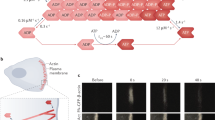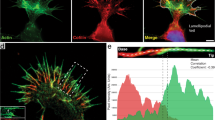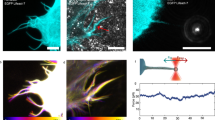Abstract
Filamins were discovered as the first family of non-muscle actin-binding protein. They are lage cytoplasmic proteins that cross-link cortical actin into a dynamic three-dimensional structure. Filamins have also been reported to interact with a large number of cellular proteins of great functional diversity, suggesting that they are unusually versatile signalling scaffolds. More recently, genetic mutations in filamin A and B have been reported to cause a wide range of human diseases, suggesting that different diseases highlight distinct filamin interactions.
This is a preview of subscription content, access via your institution
Access options
Subscribe to this journal
Receive 12 print issues and online access
$209.00 per year
only $17.42 per issue
Buy this article
- Purchase on Springer Link
- Instant access to full article PDF
Prices may be subject to local taxes which are calculated during checkout



Similar content being viewed by others
References
Hartwig, J. H. & Stossel, T. P. Isolation and properties of actin, myosin, and a new actinbinding protein in rabbit alveolar macrophages. J. Biol. Chem. 250, 5696–5705 (1975).
Wang, K., Ash, J. F. & Singer, S. J. Filamin, a new high-molecular-weight protein found in smooth muscle and non-muscle cells. Proc. Natl Acad. Sci. USA 72, 4483–4486 (1975).
Gorlin, J. B. et al. Human endothelial actin-binding protein (ABP-280, nonmuscle filamin): a molecular leaf spring. J. Cell Biol. 111, 1089–1105 (1990).
Weihing, R. R. Actin-binding and dimerization domains of HeLa cell filamin. Biochemistry 27, 1865–1869 (1988).
Stossel, T. P. & Hartwig, J. H. Interactions between actin, myosin, and an actin-binding protein from rabbit alveolar macrophages. Alveolar macrophage myosin Mg2+-adenosine triphosphatase requires a cofactor for activation by actin. J. Biol. Chem. 250, 5706–5712 (1975).
Brotschi, E. A., Hartwig, J. H. & Stossel, T. P. The gelation of actin by actin-binding protein. J. Biol. Chem. 253, 8988–8993 (1978).
Janmey, P. A., Hvidt, S., Lamb, J. & Stossel, T. P. Resemblance of actin-binding protein/actin gels to covalently crosslinked networks. Nature 345, 89–92 (1990).
Stendahl, O. I., Hartwig, J. H., Brotschi, E. A. & Stossel, T. P. Distribution of actin-binding protein and myosin in macrophages during spreading and phagocytosis. J. Cell Biol. 84, 215–224 (1980).
Weihing, R. R. The filamins: properties and functions. Can. J. Biochem. Cell Biol. 63, 397–413 (1985).
Stossel, T. P. et al. Filamins as integrators of cell mechanics and signalling. Nature Rev. Mol. Cell. Biol. 2, 138–145 (2001).
Thompson, T. G. et al. Filamin 2 (FLN2): A muscle-specific sarcoglycan interacting protein. J. Cell Biol. 148, 115–126 (2000).
Sheen, V. L. et al. Filamin A and Filamin B are co-expressed within neurons during periods of neuronal migration and can physically interact. Hum. Mol. Genet. 11, 2845–2854 (2002).
Takafuta, T., Wu, G., Murphy, G. F. & Shapiro, S. S. Human α-filamin is a new protein that interacts with the cytoplasmic tail of glycoprotein Ibalpha. J. Biol. Chem. 273, 17531–17538 (1998).
van der Flier, A. & Sonnenberg, A. Structural and functional aspects of filamins. Biochim. Biophys. Acta 1538, 99–117 (2001).
Huttenlocher, P. R., Taravath, S. & Mojtahedi, S. Periventricular heterotopia and epilepsy. Neurology 44, 51–55 (1994).
Eksioglu, Y. Z. et al. Periventricular heterotopia: an X-linked dominant epilepsy locus causing aberrant cerebral cortical development. Neuron 16, 77–87 (1996).
Kakita, A. et al. Bilateral periventricular nodular heterotopia due to filamin 1 gene mutation: widespread glomeruloid microvascular anomaly and dysplastic cytoarchitecture in the cerebral cortex. Acta Neuropathol. (Berl.) 104, 649–657 (2002).
Fox, J. W. et al. Mutations in filamin 1 prevent migration of cerebral cortical neurons in human periventricular heterotopia. Neuron 21, 1315–1325 (1998).
Sheen, V. L. et al. Mutations in the X-linked filamin 1 gene cause periventricular nodular heterotopia in males as well as in females. Hum. Mol. Genet. 10, 1775–1783 (2001).
Guerrini, R. et al. Germline and mosaic mutations of FLN1 in men with periventricular heterotopia. Neurology 63, 51–56 (2004).
Thomas, P. et al. Ehlers-Danlos syndrome with subependymal periventricular heterotopias. Neurology 46, 1165–1167 (1996).
Moro, F. et al. Familial periventricular heterotopia: missense and distal truncating mutations of the FLN1 gene. Neurology 58, 916–921 (2002).
Sharma, C. P., Ezzell, R. M. & Arnaout, M. A. Direct interaction of filamin (ABP-280) with the β 2-integrin subunit CD18. J. Immunol. 154, 3461–3470 (1995).
Calderwood, D. A. et al. Increased filamin binding to β-integrin cytoplasmic domains inhibits cell migration. Nature Cell Biol. 3, 1060–1068 (2001).
Ohta, Y., Suzuki, N., Nakamura, S., Hartwig, J. H. & Stossel, T. P. The small GTPase RalA targets filamin to induce filopodia. Proc. Natl Acad. Sci. USA 96, 2122–2128 (1999).
Marti, A. et al. Actin-binding protein-280 binds the stress-activated protein kinase (SAPK) activator SEK-1 and is required for tumor necrosis factor-α activation of SAPK in melanoma cells. J. Biol. Chem. 272, 2620–2628 (1997).
Sasaki, A., Masuda, Y., Ohta, Y., Ikeda, K. & Watanabe, K. Filamin associates with Smads and regulates transforming growth factor-β signaling. J. Biol. Chem. 276, 17871–17877 (2001).
Robertson, S. P. et al. Localized mutations in the gene encoding the cytoskeletal protein filamin A cause diverse malformations in humans. Nature Genet. 33, 487–491 (2003).
Dudding, B. A., Gorlin, R. J. & Langer, L. O. The oto-palato-digital syndrome. A new symptom-complex consisting of deafness, dwarfism, cleft palate, characteristic facies, and a generalized bone dysplasia. Am. J. Dis. Child. 113, 214–221 (1967).
Stratton, R. F. & Bluestone, D. L. Oto-palatal-digital syndrome type II with X-linked cerebellar hypoplasia/hydrocephalus. Am. J. Med. Genet. 41, 169–172 (1991).
Stoll, C. & Alembik, Y. Oto-palato-digital syndrome type II. Genet. Couns. 5, 61–66 (1994).
Gorlin, R. J. & Cohen, M. M. Jr. Frontometaphyseal dysplasia. A new syndrome. Am. J. Dis. Child. 118, 487–494 (1969).
Coste, F., Maroteaux, P. & Chouraki, L. Osteodysplasty (Melnick and Needles syndrome). Report of a case. Ann. Rheum. Dis. 27, 360–366 (1968).
Gorlin, R. J. & Langer, L. O. Jr. Melnick-Needles syndrome: radiographic alterations in the mandible. Radiology 128, 351–353 (1978).
Neou, P., Kyrkanides, S., Gioureli, E. & Bartsocas, C. S. Melnick-Needles syndrome in a mother and her son. Genet. Couns. 7, 123–129 (1996).
Zenker, M. et al. A dual phenotype of periventricular nodular heterotopia and frontometaphyseal dysplasia in one patient caused by a single FLNA mutation leading to two functionally different aberrant transcripts. Am. J. Hum. Genet. 74, 731–737 (2004).
Kaplan, J. M. et al. Mutations in ACTN4, encoding α-actinin-4, cause familial focal segmental glomerulosclerosis. Nature Genet. 24, 251–256 (2000).
Krakow, D. et al. Mutations in the gene encoding filamin B disrupt vertebral segmentation, joint formation and skeletogenesis. Nature Genet. 36, 405–410 (2004).
Author information
Authors and Affiliations
Corresponding author
Rights and permissions
About this article
Cite this article
Feng, Y., Walsh, C. The many faces of filamin: A versatile molecular scaffold for cell motility and signalling. Nat Cell Biol 6, 1034–1038 (2004). https://doi.org/10.1038/ncb1104-1034
Issue Date:
DOI: https://doi.org/10.1038/ncb1104-1034
This article is cited by
-
Role of the Ror family receptors in Wnt5a signaling
In Vitro Cellular & Developmental Biology - Animal (2024)
-
Quantification of host proteomic responses to genotype 4 hepatitis E virus replication facilitated by pregnancy serum
Virology Journal (2023)
-
Filamin A cooperates with the androgen receptor in preventing skeletal muscle senescence
Cell Death Discovery (2023)
-
The ubiquitin E3 ligase ARIH1 regulates hnRNP E1 protein stability, EMT and breast cancer progression
Oncogene (2022)
-
Intervertebral disc degeneration is rescued by TGFβ/BMP signaling modulation in an ex vivo filamin B mouse model
Bone Research (2022)



